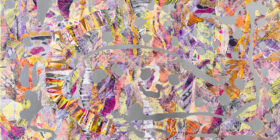Living Light: Bioluminescent Art
Hunter Cole creates Living Drawings with bioluminescent bacteria. These Living Drawings depict the cycle of life and death calling attention to our own mortality. She creates controlled line drawings using bioluminescent bacteria. The bacteria then grow on Petri dishes. Bacteria become collaborators in the art as it grows and dies. First appearing with bright light, bacteria in the drawing are photographed as it uses up available nutrients, gradually dying-off over a two-week period. She created a movie of bacterial drawings growing and dying with music based on protein sequence in the bacteria. Hunter Cole is also creating a new series called Living Light where people and objects are photographed by the light of bioluminescent bacteria. Her most recent series is called Bioluminescent Weddings where people are posed for wedding photographs by the light of bioluminescent bacteria. One of the functions of bioluminescence in nature is to attract a mate.

“Angel Bride,” photograph by the light of bioluminescent bacteria, Hunter Cole.

“Bed of Roses: Two Women Getting Married,” photograph by the light of bioluminescent bacteria, Hunter Cole.
“Angel Bride” and “Bed of Roses: Two Women Getting Married” are a part of the Bioluminescent Weddings series where people are posed for wedding photographs by the light of bioluminescent bacteria. One of the functions of bioluminescence in nature is to attract a mate.

“Rabbit: Stage 1″, photograph of drawings created with bioluminescent bacteria, Hunter Cole.

“Rabbit: Stage 2”, photograph of drawings created with bioluminescent bacteria, Hunter Cole.
“Rabbit: Stage 1” and “Rabbit: Stage 2” are a part of the Living Drawings series. When the drawing is at its brightest in “Rabbit: Stage 1”, you see the rabbit on the right and a rooster on the left. When some of the bacteria has died as in the drawing “Rabbit: Stage 2”, the rabbit is still on the right, but the rooster on the left has turned into a wolf.

“Living and Dying in Fish Swimming,” photograph of drawing created with bioluminescent bacteria, Hunter Cole.
The species of bacteria Hunter Cole uses lives in fish guts in the ocean. “Living and Dying in Fish Swimming” is spelled out using the genetic code.
Hunter Cole – Her Own DNA – Living Drawings Created with Bioluminescent Bacteria with Protein Music from Hunter Cole on Vimeo.

“X Chromosome,” photograph by the light of bioluminescent bacteria, Hunter Cole.
“X Chromosome” is a photograph taken by the light of bioluminescent bacteria. Four people are in the shape of an X chromosome. It is also a homage to Suzanne Anker’s “Difference and Repetition”. The alphabet of DNA is written in bioluminescent bacteria (A, T, G and C). There are also Xs and Ys. The X and Y relate to two XX chromosomes create a female and XY chromosomes create a male. The X and Y also relate to the unknowns in genetic technologies.

“The Entomologist I: Portrait of Bob Hamilton,” photograph by the light of bioluminescent bacteria, Hunter Cole.

“Body,” photograph by the light of bioluminescent bacteria, Hunter Cole.

“Hands” is a photograph of a plaster sculpture of Hunter Cole’s hands taken by the light of bioluminescent bacteria.

“Biological Domains,” oil on canvas and LED lights (15’ x 13’) Hunter Cole.
Hunter Cole’s recent work includes a significant public art installation acquired by Loyola University Chicago for its Lakeshore campus. Entitled, Biological Domains, the art is comprised of 14 oil paintings, six of which depict specific areas in biology. The installation incorporates LED lighting timed to create changing effects in the overall appearance of the installation throughout the day. Paintings making up the installation incorporate biological topics including: animal organ systems, plant development, stem cell research, neurology, cell and molecular biology, invasive species, malaria, bacteria, HIV, and evolutionary themes. Biological Domains is located in the Quinlan Life Sciences Education and Research Center.

“Invasive Species Takeover,” oil on canvas and LED lights (40 in. circular diameter) Hunter Cole.
Invasive species are non-native to the ecosystem being considered and tend to cause harm in their new environment. Invasive species are commonly introduced to new environments through human action either intentionally or accidentally. Waves of water are in the background. There are three female figures and a bird. Invasive species in the painting include purple loosestrife, Eurasian watermilfoil, zebra mussel and the spiny water flea.
………………..
Get the Full Experience
Read the rest of this article, and view all articles in full from just £10 for 3 months.



No comments yet.